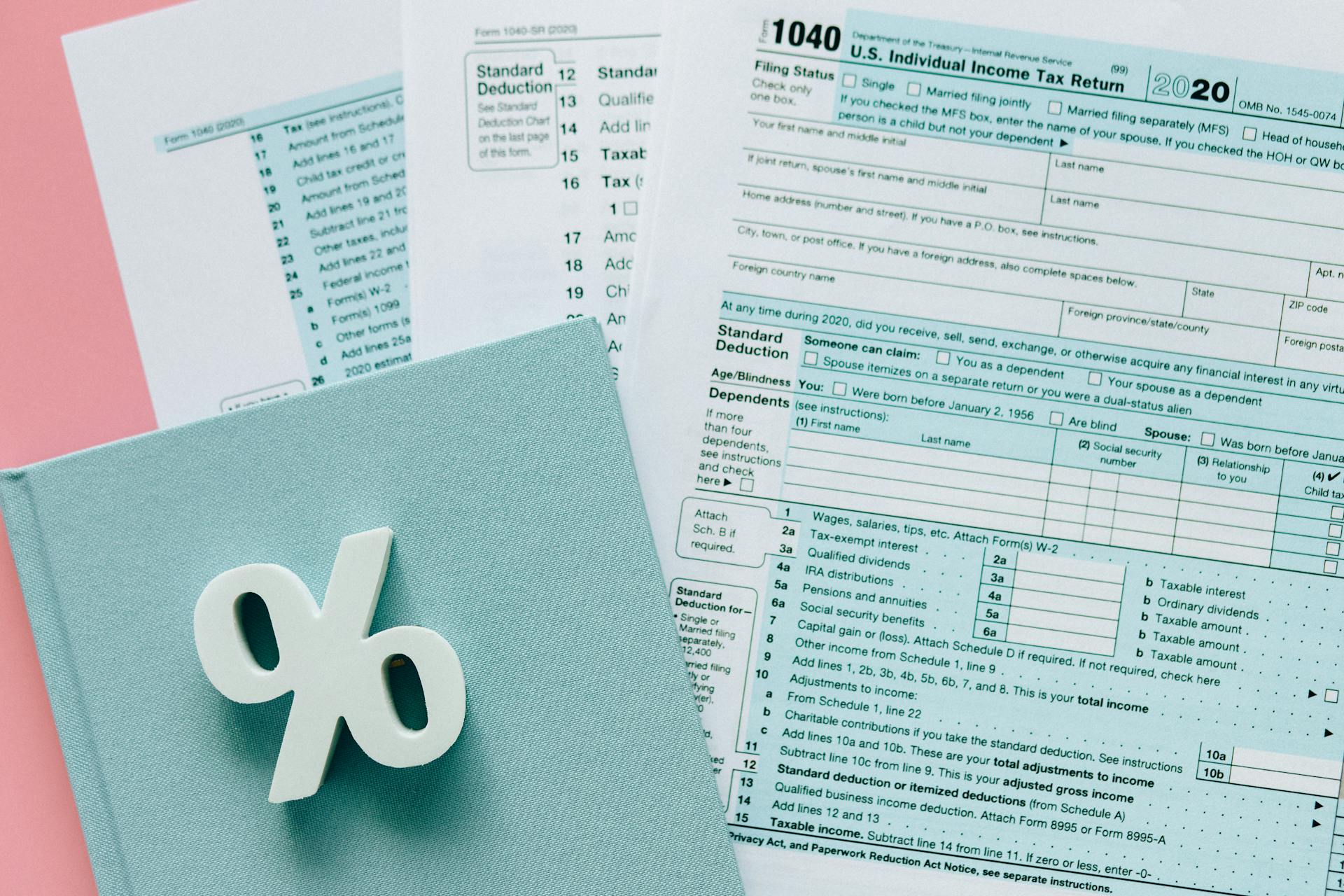
Bonds payable are a long-term liability for a company, which means they have a maturity date that is more than one year away. This is a significant difference from current liabilities, which are due within one year.
Companies issue bonds to raise capital for various purposes, such as expanding their operations or financing a new project. In return, the bondholders receive regular interest payments and the return of their principal investment.
A bond is essentially a loan that a company takes from an investor, and it's a type of debt that the company must repay. This debt is recorded as a liability on the company's balance sheet.
Bonds payable can be a good option for companies that need to raise capital for a long-term project, as they provide a fixed rate of return for the investors.
What Are Liabilities?
Liabilities are financial obligations that a company or individual must pay in the future. They can be a major concern for anyone looking to manage their finances effectively.
Long-term liabilities are debts that are due more than a year in the future, such as mortgage loans or bonds payable. This can be a significant burden, especially if not managed properly.
Short-term liabilities, on the other hand, are due within the current year and can include accounts payable and accrued expenses. These debts can add up quickly if not paid on time.
Examples of long-term liabilities include mortgage loans, which can take decades to pay off, and bonds payable, which are essentially loans from investors.
Understanding Long-Term Liabilities
Long-term liabilities are a company's financial obligations that are due more than one year in the future. These debts are listed separately on the balance sheet to provide a more accurate view of a company's current liquidity and ability to pay current liabilities as they become due.
A liability is something a person or company owes and is categorized as either current or long-term. Current liabilities are liabilities due within 12 months, while long-term liabilities are obligations not due within the next 12 months or within the company's operating cycle if it is longer than one year.
The company's operating cycle is the time it takes to turn its inventory into cash, and long-term liabilities are listed after more current liabilities on the balance sheet. They are often labeled as non-current liabilities.
Examples of long-term liabilities include the long-term portion of a bond payable, which is typically reported as a long-term liability because it covers many years. The present value of a lease payment that extends past one year is also considered a long-term liability.
Deferred tax liabilities are often considered long-term liabilities because they typically extend to future tax years. Mortgages, car payments, or other loans for machinery, equipment, or land are long-term liabilities, except for the payments to be made in the coming 12 months.
The portion of a long-term liability, such as a mortgage, that is due within one year is classified on the balance sheet as a current portion of long-term debt. This is because those payments must be covered with current assets.
Here are some examples of long-term liabilities:
- The long-term portion of a bond payable is reported as a long-term liability.
- The present value of a lease payment that extends past one year.
- Deferred tax liabilities typically extend to future tax years.
- Mortgages, car payments, or other loans for machinery, equipment, or land are long-term liabilities, except for the payments to be made in the coming 12 months.
Long-term liabilities, such as bonds payable, are formal, long-term obligations that promise to pay interest every six months and the principal amount on the date the bonds mature/come due. It is common for bonds to mature 10 or more years after the date they are issued.
Bonds Payable
Bonds payable are long-term liabilities that represent a company's obligation to repay borrowed funds to bondholders. They include periodic interest payments and the principal amount due at maturity.
Companies issue bonds to raise capital for large projects, offering investors predictable returns while preserving shareholder equity. This can be a great way for businesses to raise funds without giving up ownership or control.
Bonds payable are formal, long-term obligations that promise to pay interest every six months and the principal amount on the date the bonds mature/come due. It is common for bonds to mature 10 or more years after the date they are issued.
If the coupon rate is lower than the market interest rate, the bonds are issued at a discount, meaning the company receives less cash than the face value of the bonds. This can result in a company receiving less cash upfront, but it can also reduce the risk of default.
Bonds Payable Definition
Bonds payable are formal, long-term obligations that promise to pay interest every six months and the principal amount on the date the bonds mature/come due. It's common for bonds to mature 10 or more years after the date they are issued.
Bonds payable are a type of loan, where an institution borrows money from the public in exchange for interest payments over a set period. The contract that holds this deal in place is called a bond, and the interest rate paid on the bond is called the coupon rate.
The institution borrowing the money and issuing the bond is called the bond issuer, and the investors giving the money are called the bondholders. The bond world can get complex, but for our purposes, understanding the basics is enough.
Bonds payable are classified as long-term liabilities and current liabilities, depending on their maturity date. If the bonds will be maturing within one year of the balance sheet date, they will be reported as a current liability.
The amount of bonds payable will be found in the company's balance sheet and is called bonds payable. It represents a series of regular interest payments together with a final principal repayment at the maturity date.
Here's a breakdown of the key components of bonds payable:
- Bond issuer: The institution borrowing the money and issuing the bond
- Bondholders: The investors giving the money
- Coupon rate: The interest rate paid on the bond
- Bond maturity date: The date when the bond expires and the principal amount is repaid
- Face value: The par value of the bond, usually $1,000
- Bonds payable: The amount of the liability on the company's balance sheet
Benefits
Bonds payable offer several advantages for companies and investors. One of the key benefits is that bonds often have lower interest rates compared to other forms of borrowing, such as bank loans.
This cost-effective financing option can help companies save money on interest payments. For example, a company might be able to secure a bond with a 5% interest rate, whereas a bank loan might come with a 10% interest rate.
Issuing bonds also preserves ownership of existing shareholders. This is because bonds are debt instruments, not equity instruments, so issuing them doesn't dilute the ownership of existing shareholders.
Fixed interest payments provide clarity for financial planning, making it easier for companies to budget and forecast their future cash flows. This predictability can be especially useful for companies with irregular income or expenses.
Bonds offer investors a steady income through periodic interest payments, providing a sense of security and stability. This can be especially appealing to investors who are looking for a low-risk investment option.
Accounting for Long-Term Liabilities
Long-term liabilities are a company's financial obligations that are due more than one year in the future. These debts are listed separately on the balance sheet to provide a more accurate view of a company's current liquidity and ability to pay current liabilities as they become due.
Long-term liabilities are categorized as obligations not due within the next 12 months or within the company's operating cycle if it is longer than one year. A company's operating cycle is the time it takes to turn its inventory into cash.
A company's liabilities appear on its balance sheet, with long-term liabilities listed after more current liabilities. These often include debentures, loans, deferred tax liabilities, and pension obligations.
The current portion of long-term debt is the portion of a long-term liability that is due in the current year. This is typically listed separately on the balance sheet because these liabilities must be covered with current assets.
Bonds payable represent a contractual obligation between a bond issuer and a bond purchaser. The exact terms of bonds will differ from case to case and are clearly stated in the bond indenture agreement.
The benefit of issuing bonds rather than issuing stock is that debt is considered a "cheaper" source of financing as long as the default risk is kept at a manageable level.
Long-Term Debt
Long-term debt is a type of liability that companies owe and is due more than one year in the future. This can include the long-term portion of a bond payable, which is typically the majority of the bond.
A company's operating cycle, the time it takes to turn its inventory into cash, can also determine the classification of a liability as long-term. If the operating cycle is longer than one year, liabilities not due within that time frame are considered long-term.
Examples of long-term liabilities include mortgages, car payments, or other loans for machinery, equipment, or land, except for the payments to be made in the coming 12 months.
Current Long-Term Debt Portion
The current portion of long-term debt is a crucial aspect of a company's financial health. It's the amount of long-term debt that is due within the next 12 months.
This portion of long-term debt is often overlooked, but it's essential to consider when evaluating a company's liquidity and ability to pay its debts. Think of it like a mortgage – you may have a 30-year mortgage, but you still need to make payments on the current year's portion.
The current portion of long-term debt is typically listed separately on the balance sheet, alongside current liabilities. This is because these debts must be covered with current assets, such as cash or accounts receivable.
Here are some examples of long-term liabilities that have a current portion:
- Mortgages: The portion of a mortgage payment due within the next 12 months is considered current long-term debt.
- Bonds payable: The current portion of a bond payable is the amount due within the next 12 months.
- Leases: The present value of lease payments due within the next 12 months is considered current long-term debt.
It's essential to keep track of the current portion of long-term debt to ensure a company has sufficient current assets to cover these obligations.
Challenges
Long-term debt can be a double-edged sword. On one hand, it can provide a company with the necessary funds to grow and expand its operations. On the other hand, it comes with its own set of challenges.
One major challenge is interest rate risk, which can significantly impact the market value of bonds. This can be particularly problematic for companies that have issued bonds at a time when interest rates are high, only to see them drop later on.
Regular interest payments can also put a strain on a company's cash reserves, especially during periods of low revenue. This is known as cash flow pressure.
Another challenge is default risk, where the issuer fails to meet payment obligations, leaving bondholders with losses. This is a risk that investors should be aware of before investing in bonds.
The process of issuing bonds is also complex, involving legal, regulatory, and administrative complexities. This can be a daunting task for companies that are not familiar with the process.
Here are some of the key challenges associated with long-term debt:
- Interest Rate Risk
- Default Risk
- Cash Flow Pressure
- Complex Issuance
Long-Term Debt Management
Long-term debt management is crucial for any business or individual with long-term liabilities. Long-term liabilities are financial obligations that are due more than one year in the future.
These debts are listed separately on the balance sheet to provide a more accurate view of a company's current liquidity and ability to pay current liabilities as they become due. Long-term liabilities are also called long-term debt or noncurrent liabilities.
A company's operating cycle is the time it takes to turn its inventory into cash, and long-term liabilities are obligations not due within the next 12 months or within this cycle. Long-term liabilities appear on a company's balance sheet, listed after more current liabilities.
Examples of long-term liabilities include the long-term portion of a bond payable, deferred tax liabilities, and mortgages or car payments for machinery, equipment, or land. The portion of a long-term liability due within one year is classified as a current portion of long-term debt.
Here are some key points to consider when managing long-term debt:
- The long-term portion of a bond payable is typically the majority of the bond payable.
- Deferred tax liabilities are considered long-term liabilities because they extend to future tax years.
- Mortgages, car payments, or other loans for machinery, equipment, or land are long-term liabilities, except for the payments to be made in the coming 12 months.
Liability Accounting
Long-term liabilities are a company's financial obligations that are due more than one year in the future. These debts are listed separately on the balance sheet to provide a more accurate view of a company's current liquidity and ability to pay current liabilities as they become due.
Bonds payable represent a contractual obligation between a bond issuer and a bond purchaser. This agreement involves the issuer obtaining financing in exchange for promising to make interest payments in a timely manner and repay the principal amount to the lender at maturity.
The interest on bonds is normally paid on a semi-annual basis, i.e. every six months until the date of maturity. The exact terms of bonds will differ from case to case and are clearly stated in the bond indenture agreement.
For corporations, issuing bonds rather than stock is considered a "cheaper" source of financing as long as the default risk is kept at a manageable level.
Sources
- https://www.investopedia.com/terms/l/longtermliabilities.asp
- https://accountingsuperpowers.com/financial-statements/balance-sheet/liabilities/bonds-payable/
- https://auroratrainingadvantage.com/accounting/key-term/bonds-payable-accounting-guide/
- https://www.accountingcoach.com/blog/bonds-payable-current-liability
- https://www.wallstreetprep.com/knowledge/bonds-payable/
Featured Images: pexels.com


